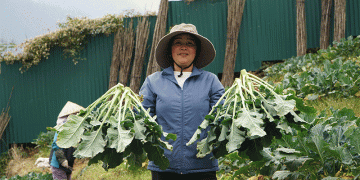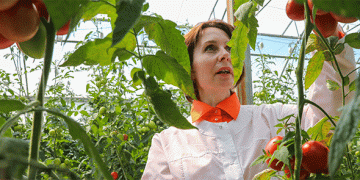As U.S. asparagus consumption rises, producers are looking for ways to take the mystery out of cooking the vegetable.
A new microwavable line of fresh-cut asparagus was introduced in April from Cedarville, N.J.-based Sheppard Farms. Sold through King’s supermarkets in New Jersey, the product is the result of collaboration between Rutgers University and Sheppard Farms.
Tom Orton, Extension specialist with Rutgers Agriculture Research Center and part of the Food Innovation Center, said the microwavable asparagus package took about 14 months to develop, a short amount of time compared to many new product rollouts. He, along with packaging consultant William Romig, looked for new ways to use an innovative package.
“We took an existing package and modified it,” he said. “It was basically technologies that were already in existence and we took them and applied them in different ways.”
The double-washed asparagus is sold in either a 10-ounce bag or tray, each with microperforations and pressure-activated steam vents. The microperforations extend the shelf life of the asparagus by allowing oxygen and carbon dioxide to set up an atmosphere that will slow down decomposition. Orton said the shelf life exceeds 21 days, compared with 10 to 12 days for fresh asparagus bundles.
The package’s steam vents allow the asparagus to cook in a microwave. The produce cooks through convection, not from the microwaves, Orton said. The liquid water in the produce is turned to steam, the agent that does the cooking.
It takes between two minutes and four minutes to cook the asparagus in the microwavable package. Buyers can make it to their preference, with less cooking time for crispier vegetables and more time for softer asparagus.
The asparagus is grown at Sheppard Farms, which dedicates about 150 acres of its 1,500 acres to asparagus production. Production of asparagus is from April 15 to June 15, and is primarily Jersey Knight and Jersey Giant varieties. The farm also grows bell peppers, iceberg lettuce, romaine lettuce, cucumbers, zucchini and squash.
Tom Sheppard and his brothers, Dave and Erwin, run Sheppard Farms. Fourteen generations of the Sheppard family have farmed in the state for more than 300 years. The farm dates back to 1683, and Sheppard said some of the land they now farm has been in the family since the 1800s. The farm is located in Cumberland County, the leading producer of vegetables in New Jersey. According to the county’s Web site, it is the “Garden Spot of the Garden State,” producing about 16 percent of New Jersey’s total agricultural value.
Product Roll-Out
Sheppard said when Orton and Romig approached him about the package, he knew right away that asparagus was the right product, but the company had never rolled out a new product.
“It was an interesting process,” Sheppard said. “They have people with product development experience, but it wasn’t something we had experience with.”
So far, the response from consumers has been mixed, both men said. As with any new product roll-out, there can be bumps in the road, and it’s a learning process. Customers responded well to the new product and sales started off strong, but dropped off soon after introduction.
“Most of the produce managers were very pleased with the product,” Orton said. “When it first arrived, it moved very well.”
Sheppard said they ran behind schedule with little things, and it seemed like “everything that could go wrong did go wrong.”
Although initial sales were strong, Sheppard said they didn’t sell as much as he thought they might.
Orton said they also ran into a problem with condensation. It makes the produce less visible and could cause lost sales. Films get condensation, but that can be avoided by keeping the temperature between 30˚ F and 40˚ F. He said they found some stores that were displaying the product improperly, with temperatures as high as 50˚ F or set up under misting equipment.
“You can always do more and can always work more closely with retailers,” Orton said.
The microwavable packages should be displayed in the same environment as fresh-cut bagged salads. He also said they were looking at anti-fog films to reduce condensation problems.
Consumer Education There was some confusion on the part of consumers as well. Since the product was released at the same time as fresh asparagus came to the market, consumers did not see the innovation as locally produced.
“Consumers are confused about what the source of the product is and how does it relate to conventional asparagus they are used to buying,” Orton said.
He said they were working to combat this by educating consumers with packaging, labels and in-store displays about the benefits and local aspect of the new package.
Despite the setbacks, both men were looking to the future. Sheppard said he hoped one day to sell the microwavable asparagus year round. He wanted to bring in asparagus from other regions throughout the year, since his farm produces fresh asparagus for only two to three months in the spring. He said the company was now looking at equipment and production issues for the microwavable packages next season. He planned on next fall or possibly next summer for the next offering.
Orton said he was working on plans for new products in the microwavable packaging. He plans to start research this summer on microwavable packages for stir fries, squash, peppers, vegetable mixes and sweet corn on and off the cob. Because the produce is cooked by steam, Orton said the end product had fewer calories and was healthier than other microwavable produce.
“I believe that it will lead to a market expansion, ultimately by taking marginal consumers and making a product available to them that they think is easier to prepare,” Orton said.
New Jersey is the fourth-highest asparagus producing state in the United States, behind California, Michigan and Washington. According to the New Jersey Farm Bureau, New Jersey farms about 1,100 acres of asparagus, and in 2005 yielded 30 cwt.
Rutgers University is home to one of the few remaining breeding programs in the world. Researchers have created 10 hybrid asparagus varieties and are prepared to introduce four more varieties in 2007. Orton said New Jersey is a good place for breeding because there are many diseases, which provides for the best selection under adverse conditions. Plant varieties that were developed in the state tend to do well across the board, he said.




























